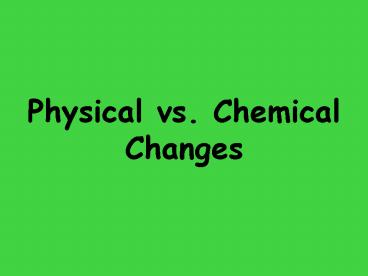Physical vs. Chemical Changes - PowerPoint PPT Presentation
1 / 20
Title:
Physical vs. Chemical Changes
Description:
Physical vs. Chemical Changes Goal: How do you tell the difference between chemical and physical changes? Physical Change* A change in any object s physical ... – PowerPoint PPT presentation
Number of Views:82
Avg rating:3.0/5.0
Title: Physical vs. Chemical Changes
1
Physical vs. Chemical Changes
2
Goal How do you tell the difference between
chemical and physical changes?
3
- Physical Change
- A change in any objects physical properties
- any change in an objects
- - mass - color
- - weight - shape
- - volume - hardness
- - density - texture
4
Physical Changes
- Changes in Density, Mass or Volume D M/V
5
Physical Changes
- Creating mixtures that can be separated out -
mixtures can be reversed.
6
Physical Changes
- Changes in Phase of Matter
7
Example of a Physical Change
A Melting Icicle
8
- physical properties characteristics of a
substance that can be observed without changing
the identity of the substance. - ex.) wood is still wood whether it is shaped
into a baseball bat or used to build the walls of
your house or if its still in the shape of a
tree! - ex.) water is still water whether it is in the
form of ice, liquid water, or water vapor. Its
still H2O!
9
Review Other Physical Properties
- Color
- Size
- Shape
- Texture
- Magnetism
10
Chemical Changes
- Chemical Changes occur when atoms react with
other atoms to form chemical bonds. - When atoms are bonded together they make a
molecule.
11
Chemical Changes
- When a chemical reaction happens the new
molecules are a new substance or compound. - A B ? AB
12
- Chemical Change
- gt changes that substances undergo when they turn
into other substances - gt Also called a Chemical Reaction
- ex.) as coal burns, O2 (in the air) combines
chemically with C (the substance that makes up
most of the coal) and forms a completely new
substance CO2 - - C and O2 have changed chemically! They
- no longer exist in their original
forms! - - Written out C O2 CO2
13
Evidence of Chemical Changes, Reactions or Bonding
- Energy being taken in or given off (heat,
coolness, light)
14
Evidence of Chemical Changes, Reactions or Bonding
- Gas or Bubbles
15
Evidence of Chemical Changes, Reactions or Bonding
- Color or Texture Change
16
Evidence of Chemical Changes, Reactions or Bonding
- Color and Texture Change that is not easily
reversed
17
Evidence of Chemical Changes, Reactions or Bonding
- Forming of a Precipitate (adding to solutions and
a solid is formed)
18
How to decide type of change
- Ask yourself Can I easily turn substance back to
the way it was? - If yes physical change
- If no chemical change
- Was the change awesome to watch?
- If yes Probably chemical change
- If no Probably physical change
- Did the name of the new substance change?
- If yes Probably chemical
- If no Probably physical
19
Examples of Chemical Change
- The rusting of iron
- The baking of bread
- Burning of a match
- Fireworks
20
Example of a Chemical Change The Electrolysis
of Water (H2O)
The Chemical Identity of Water ( H2O ) is changed
into the elements Hydrogen ( H2 ) and Oxygen ( O2
)































